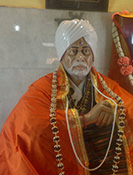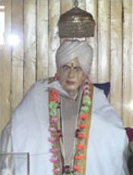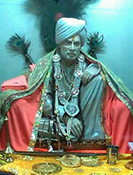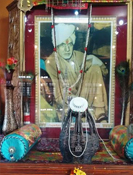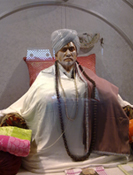The Flow of Vitasta
Bab Bhagawaan Ji would adore the Vitasta river, as He would revere the Divine Mother, Shri Raginya Bhagawati. Shri Raginya and the Vitasta are the manifestations of the Jala Tattva among the Pancha Mahabhutas.
It has been said by the great Rishis, ascetics and men of spiritual realization that Vitasta is the Parvati incarnated as the flow of the Vitasta. Turn the pages of the Nilamata Purana, which is the socio-religious scripture of the Kashmiri Pandit heritage, it is the story of the incarnation of the Vitasta, on the Vyetha Truwah Tithi. The legend says:
Yani Tirthni Bharata Varshe, Tani Tirthani Kashmir Mandale
Yani Tirthani Kashmir Mandale, Tani Tirthani Nadi Vitastayam
The Shloka clearly suggests that all the Tirthas of the Bharata Varsha have taken their abode in the valley of Kashmir. But all the Tirthas of Kashmir find their ultimate abode in the Vitasta Nadi, which in popular Kashmiri language is known as the Vyeth. Nadi in English is translated as river. The spiritual source of the Vitasta is the Purna Prakriti, the Divine Mother, but through our perception Vyetha-Vottur is its source, which receives its feed back from the Veri Nag spring.
A Svayambhu Shiva lingam, being adored as VOMU/ OM is adored by the devotees, at the source spring of Vetha Vottur. since times immemorial. This establishes the fact that Kashmir is Shaiva in Philosophical attainments, and Shakta in ritualistic pattern. Bab Bhagawaan ji would ask his devotees to revere the river Vitasta,as being the very reflection of the Mother Parvati.
The Bhadra Shukla Trayodashi, or Vyatha Truvah, as it is revered in the religious ethos of Kashmir is the 13th lunar digital day of the month of Bhadra Pada. Generally this day falls in the month of August or September.This is the very auspicious day for the people of Kashmir ,because the Vyeth got incarnated that day and its constant flow speaks of its grandeur from Vetra Vatti, which is Vyeth Vottur. The Vetra Vatti is one of the forms of Bhavani, as explained by Shiva to his disciple Nandi, as the glory of the Divine Mother. Reference to this effect is in the Bhavani- Sahsranama -Namaavalli.Bab Bagawaan Ji would recite the Bhavani Sahsranama,and would advise his devotees, to learn theBhawani Sahsranama with heart.
Much water has flown from the river, since it got incarnated on the Reshi Vatika--the spiritual garden of the Rishis of Kashmir. The people of Kashmir have got special reverence for this sacred river. The devotees would offer their Sandhya-twilight prayers on its banks at the early dawn, followed by theTarpana,which is the water oblations to their ancestors . They would bring water from Vitasta in a Gadha,which is a small pitcher of copper or brass, to be offered to the Murtis and on the Shiva Lingam at the temples constructed on the banks / Ghats, popularly known as the Yaarbal in the Kashmiri language. People were seen in the temples from Shurah Yaar near the Durga Nagh-Badami Bagh area., which is the first temple of the Srinagar city.But according to Shri Pran Nath Kaul,Bab Baghawan jiwould offer Sandhya in his own room.
Close to Ganapat Yaar on the banks of the river is the Bhagvan Gopi Naths Ashram known as the Vaihkuri Yaar or the Kharyar. It is because of the linguistic changes, as we see in the Apbhramsha, Vaikhuri Yaar has become the Khar Yaar. This is a center of Sadhana for thousands of people. Soomyaar is considered as the important Tirtha for the Kashmiri Hindu women, as this Tiratha on the banks of the Vyeth is at the Habba Kadal bridge. This Tiratha is associated with the Somavati Amavasya.
How was Vyetha Truvah observed? The Kashmiri Pandits would go to their respective Ghaths/ Yarbal and would offer water to the sacred river Vitasta. They would offer Tomlu- Tchochi Worya or the bread made from the rice flour to the Vitasta river as an offering and would read the Shlokas from the Vitasta Mahatmyam. In the evening, the Hindu women would go and offer Tchong, which is earthen lamp/ Diya or Deepak to the river and would keep the Tchong lit to illumine the banks of Vitasta.Vyeth is the life-breath of the Kashmiri Pandit ethos.' 'We love her as we love our mother",was the Mool Mantra for adoring the river Vitasta . How can we forget her? She is not mere water resource, but she is inspiration to live a Kashmiri way of life, which is spiritual in essence.
In all her acts, a strange Divinity of Vitasta would welcome with a smile. This was the common feeling of Bhagavaan ji in Kashmir. When our ancestors were called back with the great efforts of Shri Bhat, the Vitasta made herself presentable, as the source of spiritual experience. This feeling has maintained the sanctity of Vyeth. Vitasta is in our dreams of delight, in our wakeful thoughts. and in our spiritual environment. Even here, we need to celebrate the Divinity of the Vitasta, as Bab Bhagavaan ji would offer his obeisance to the Vitasta river
Kashmiri Pandit is closely associates with the Vitasta, as the Nirmalya was supposed to be disposed off as an oblation in the Vitasta. All the tenth day Kriya was necessarily to be done on the banks of the River Vitasta. We find our cultural roots in the Vitasta.
Dr Chamanlal Raina






